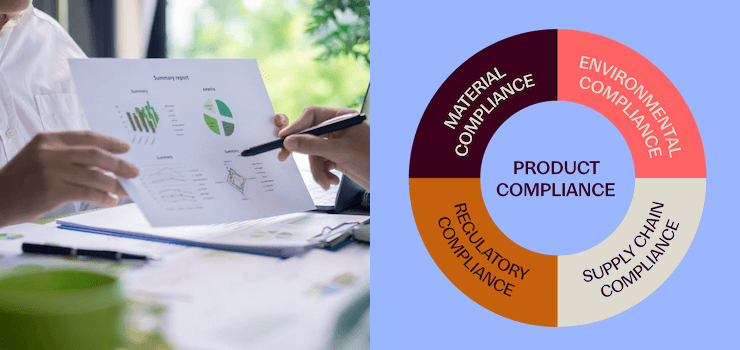Meeting all local and global regulatory requirements is a must for all companies doing business in the 21st century. Consequently, a robust material compliance process with sophisticated tools is necessary to ensure compliance with the ever-changing laws to avoid recalls, fines, costly redesigns, and bad public press.
However, developing robust material compliance processes and tools is a complex task, and it is very difficult to achieve alone. For the automotive industry, it took almost three years for the seven OEMs working with EDS (Electronic Data Systems) to agree on and develop a central database called VDA/EDS system, which was renamed to IMDS and launched in June of 2000. In the first few years after the launch, all OEMs and suppliers were struggling to achieve high-quality data inputs into IMDS. It took four years until IMDS reporting became a mandatory requirement – with PPAP (Production Parts Approval Process) coming into place in 2004. A year later, GADSL (Global Automotive Declarable Substance List) was issued, further helping the IMDS ecosystem to standardize. Data quality has been a continuous improvement task until now. Not only this process took a lot of time, but it was also quite costly: Judging by the size and reach of the system, the cost of developing IMDS with all the supporting infrastructure, over 20 years, is likely in the billions.
The value of IMDS and data
Nonetheless, many companies have come to realize the value of IMDS and the data collected as well as individual material compliance processes and tools set up within each company. IMDS effectively helped many organizations better utilize data required to comply with the ELV Directives in the early years, and later to cover even more regulatory requirements such as REACH, US TSCA, California Prop 65/SCP, and WFD (SCIP).
Looking back at the last 15-20 years, one may discover that many sustainability goals and targets companies established on a voluntary basis have now actually become regulatory requirements. Customers, environmentalists, NGOs, and governments often encourage companies to set sustainability goals and develop technologies and infrastructures to use more recyclable, renewable, reusable, and lightweight materials. EU governments are actively looking to boost the use of recyclable and reusable materials, particularly for critical materials. The End of Life Vehicles Directive and the related RRR (Reusability, Recyclability, Recoverability) Directive come with certification requirements, which started in the EU and now extend to other countries and regions. To go one step further, in order to remove barriers to recycling, the EU is making SVHC compliance reporting mandatory from January 2021 as part of the EU WFD requirements in its SCIP database (Substances of concern in articles as such or in complex products). The recent EU Green Deal initiatives are yet another example of regulations designed to shape a more sustainable future, in this case by ensuring the EU’s climate neutrality by 2050. In July 2020, the EU announced to add “plastic packaging waste taxes and CO2 border taxes starting 2021 and 2023 respectively” to drive the circular economy adoption using economic measures. More recent examples include the Dutch Child Labor Due Diligence Act (2019), the Australia Modern Slavery Act (2019), and proposed legislation in Germany and the EU requiring companies to undertake human rights and environmental due diligence. We expect that many sustainability initiatives of today are likely to become regulations of tomorrow.
The digital twin – a real game changer
Thanks to digitalization, new tools and innovations revolutionizing material lifecycle management have entered the scene. For example, the “digital twin”, an adaptive virtual model of a physical product, which is supported and accessible throughout the entire digital circular economy lifecycle, can have a huge impact on almost every aspect of product life cycle management. Digital twins can help organizations establish traceability of materials, components, parts and products from design, development, and manufacturing, throughout the use and reuse phase, to the material recovery phase. Digital twins have brought a big change to traditional ways of managing material life cycles and have contributed to the emergence of new business models.
Many companies have recognized the necessity of shortening product development cycles and improving engineering efficiency – which is vital for a company’s success and survival in such a competitive market. By using digital tools and integrating substance and material data related to their compliance status, environmental impact, as well as alternative selection abilities into product manufacturing processes, companies can reduce or even eliminate a range of costly and time-consuming activities, e.g., physical testing, inspection, verification, and certification, to name but a few.
The general trend also shows that companies are shifting their focus towards a more holistic material life cycle management driven not only by regulatory requirements, but also by corporate sustainability and business efficiency requirements.
This article is the third in our new series of nine articles dedicated to the topic “From Compliance to Sustainability – Managing Material Lifecycle in the Circular Economy Era”. It is addressed to senior decision makers, managers, compliance officers, engineers, and any corporate citizen interested in the most important steps of your journey from compliance to sustainability. Starting with material compliance, we will explore the entire material life cycle and the connections between corporate sustainability goals, circular economy, and digital technology. Thereby, we will lay the focus on business processes, IT solutions, and the utilization of data as the three key elements which – in combination with sustainability and the circular economy – create greater value for companies and their value chains.
Our next article in this series, focus on the current state on the why end-to-end material lifecycle management is key.
About the authors
Maroye Marinkovic is the Product Innovation Manager at iPoint, where he brings in his skills as a solution designer, digital strategist, and a communicator with a passion for improving sustainability, efficiency, and compliance across value chains. Based in Melbourne, Australia, he has more than 10 years of experience in conceptualizing, designing, and implementing enterprise compliance, sustainability, and risk management software solutions. Maroye’s specializations include chemicals management, platform design, blockchain solution design, circular economy, and business strategy.
Dr. Bing Xu joined iPoint in Ann Arbor, Michigan, at the North America main office in 2019 as Director of Business Innovation. In this role, he supports iPoint’s customers in different industries with their material compliance programs as well as their sustainability, circular economy, and digital twin projects, to integrate material compliance programs into their core product development processes and reduce non-compliance risks and improve engineering efficiency.
Before joining iPoint, Dr. Xu was Ford Motor Company’s Global Materials Compliance Program Manager. Spearheading Ford’s Global Materials Management program in early 1997, he was one of the original OEM members who developed and launched the International Data Management System (IMDS) for the automotive industry in 2000. He was Ford’s global attribute leader for material/substance compliance and material life cycle management, and a member of Ford’s Sustainability Council, managing both internal compliance and external suppliers’ compliance. He also led Ford’s cross-functional teams and developed various material compliance-related processes and IT tools for Ford since 1997. Furthermore, Dr. Xu was the owner of Ford’s Restrictive Substances Management Standard (RSMS) and the owner of the Ford’s internal material/substance compliance processes/tools.
He has served as chair and co-chair in several committees of leading industry organizations and work groups, such as the US Automotive Industry Action Group (AIAG)’s Chemical Management Advisory Group, the United States Council for Automotive Research (USCAR)’s Substances of Concern Group, the Global Automotive Declarable Substance List (GADSL)’s Steering Group; and he has supported projects of the US Environmental Protection Agency (EPA) on Alternative Assessments, and TSCA industrial data collection and evaluations.
A recognized and highly respected expert of the automotive industry, he has been invited to speak at many conferences and forums hosted by different industries and governmental agencies, e.g., Electronics, Building Materials, Heavy Machinery, Chemicals, Apparel, Home Appliances, California Safer Consumer Products and Alternative Assessment conferences/workshops, and SAE US Government Industry Meeting.





.png)
